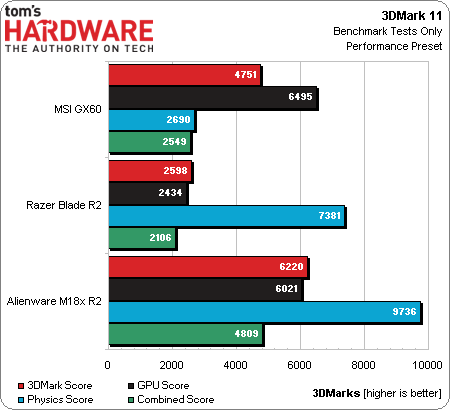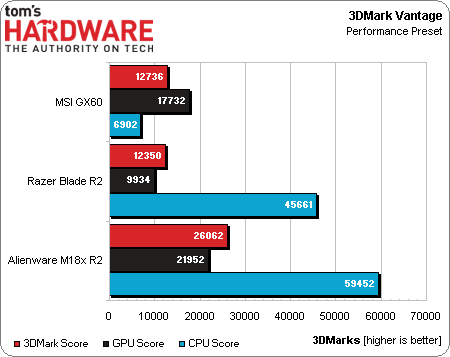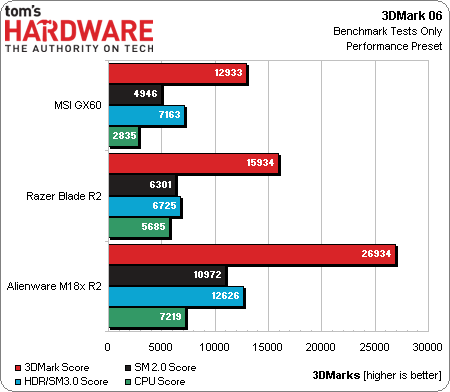MSI GX60 Review: Radeon HD 7970M In A $1,200 Notebook!
MSI's GX60-series notebook is in our lab today. Armed with Radeon HD 7970M graphics, a 15.6" display, and triple-screen output, this is truly a desktop replacement. But can its AMD A10-4600M APU keep pace with gaming platforms armed with Intel CPUs?
Synthetic Benchmarks: 3DMark
With the latest version of 3DMark available, we know that 3DMark Vantage and 3DMark 06 are beginning to show their age. However, both tests still offer unique insight as far as system performance goes, and they allow us to compare older hardware that you might still own. Comparisons were made to the recently-reviewed Razer Blade R2 with the Nvidia GTX 660M, as well as an Alienware M18x with the top-of-the-line Nvidia GeForce GTX 680M.
In the chart above, the GPU and Physics scores give us a lot of information about the individual performance of the AMD A10-4600M APU and Radeon HD 7970M GPU. The Radeon shows itself to be faster than Nvidia’s best GeForce GTX 680M. What’s more, the Radeon is almost three times as fast as the GTX 660M, which is often found in systems with similar, or sometimes even higher, price tags than MSI's GX60.
The A10-4600M APU falls behind in the Physics score against the pair of quad-core -i7 CPUs. Even though the A10-4600M is also a quad-core chip, it performs more like a dual-core part as a result of its shared resources.
These results show the main tradeoff that MSI made to lower the GX60’s price. The GPU is faster than anything out there, while the CPU lags far behind Intel’s quad-cores. In a machine built to game at the lowest possible cost, this tradeoff seems reasonable. As long as the CPU can keep up with the GPU, there should be no loss of gaming performance.
3DMark Vantage lowers the number of advanced rendering features these GPUs have to render. The GTX 680M pulls ahead in GPU scoring, while differences in CPU scores are significantly more pronounced.
Falling back to DirectX 9, 3DMark 06 further alters the GPU results, favoring Nvidia's card. But we do get a sense for how each system might perform in older titles. The CPU results come close to indicating real-world performance, with the A10-4600M running at about half the speed of Intel's Core i7-3632QM.
Overall, 3DMark testing confirms what we expected: GPU performance is stellar, while CPU performance is less than impressive compared to high-end offerings from Intel. How the GX60’s APU and GPU perform together in actual games is what we really want to know now. Intel’s top-of-the-line Core i7-3940XM is 3.5 times faster than the GX60’s A10-4600M in 3DMark 11, but the Core i7-3940XM costs almost $1,100. The whole GX60 package is only $100 more than that one chip! So, how much is 3.5x the CPU speed worth? If you are a gamer getting the same frame rates, do you even care?
Get Tom's Hardware's best news and in-depth reviews, straight to your inbox.
Current page: Synthetic Benchmarks: 3DMark
Prev Page Test Setup And Benchmark Suite Next Page Productivity Benchmarks-
yobobjm I own an MSI (with some weird number classification that I can't remember) but it has proved to be a dedicated and powerful gaming laptop. It also has had really no problems other than the glossy finish getting scratched (which doesn't even exist on this laptop) so I would recommend MSI products :DReply -
flowingbass I also own an MSI, a GX660r with a 5870M and a Core i5 480m. The 5870M desktop equivalent is a HD5770. The GPU is quite struggling to play on high in current games, mid-high or sometimes medium (all low on crysis 3 except resolution and textures) is required to maintain playable frame rates.Reply
I might just upgrade to this and just swap GPU between the two. i5 480m > A10-4600M -
acktionhank Hey Tom's run a few gaming tests again with PScheck forcing the CPU to run at a 2.5-2.7ghz so that it won't throttle itself so much.Reply
I'd like to see exactly what speeds we'd need to get an A10-4600 running at to reduce these severe bottlenecks. -
silverblue Very nice machine. It's a shame that AMD stopped with the A10-4600M and didn't look to produce a higher model as that'd help, however until the HSA initiative really kicks in, the Bulldozer architecture's FPU implementation is always going to be found wanting, and that's without even talking about the sharing issues which Steamroller looks to fix.Reply


